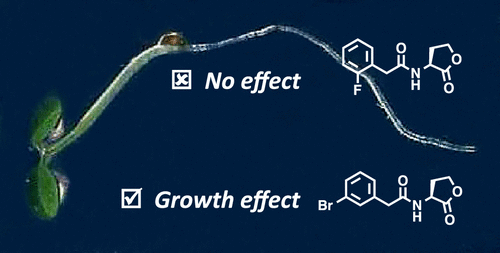当前位置:
X-MOL 学术
›
ACS Chem. Biol.
›
论文详情
Our official English website, www.x-mol.net, welcomes your
feedback! (Note: you will need to create a separate account there.)
Selection of Appropriate Autoinducer Analogues for the Modulation of Quorum Sensing at the Host–Bacterium Interface
ACS Chemical Biology ( IF 3.5 ) Pub Date : 2018-10-08 00:00:00 , DOI: 10.1021/acschembio.8b00676 Andrew G. Palmer 1 , Amanda C. Senechal 2 , Timothy C. Haire 1 , Nidhi P. Mehta 1 , Sara D. Valiquette 1 , Helen E. Blackwell 2
ACS Chemical Biology ( IF 3.5 ) Pub Date : 2018-10-08 00:00:00 , DOI: 10.1021/acschembio.8b00676 Andrew G. Palmer 1 , Amanda C. Senechal 2 , Timothy C. Haire 1 , Nidhi P. Mehta 1 , Sara D. Valiquette 1 , Helen E. Blackwell 2
Affiliation

|
Bacteria regulate a variety of phenotypes in response to their population density using quorum sensing (QS). This phenomenon is regulated by small molecule or peptide signals, the best characterized of which are the N-acyl l-homoserine lactones (AHLs) utilized by Gram-negative bacteria. As many QS-controlled phenotypes, notably pathogenicity and symbiosis, can profoundly impact host eukaryotes, there is significant interest in developing methods for modulating QS signaling and either ameliorating or augmenting these phenotypes. One strategy has been the use of non-native AHL analogues to agonize or antagonize specific AHL receptors. This approach is complicated, however, by the potential for prospective hosts to respond to both native AHLs and synthetic analogues. Accordingly, identifying AHL analogues with little or no activity toward eukaryotes is important in developing QS modulation as a strategy for the regulation of prokaryotic behaviors. Herein, we utilize the model plant Arabidopsis thaliana to characterize eukaryotic responses to a variety of synthetic AHL analogues to identify structural elements of existing scaffolds that may elicit responses in prospective hosts. Our results indicate that, while many of these compounds have no discernible effect on A. thaliana, some elicit strong phenotypes similar to those produced by auxin, a hormone involved in almost all aspects of plant development. We outline concentrations and chemical scaffolds that are ideal for deployment on plant hosts for the regulation of QS. This approach should be exportable to other eukaryotes for the selection of optimal AHL tools for the study of QS at the host–microbe interface.
中文翻译:

选择合适的自诱导物类似物以调节宿主-细菌界面上的群体感应
细菌根据群体密度使用群体感应(QS)来调节多种表型。这种现象是由小分子或肽的信号调节,最好其特征在于,其被所述Ñ酰基升革兰氏阴性细菌利用的β-高丝氨酸内酯(AHL)。由于许多QS控制的表型(尤其是致病性和共生性)可以深刻影响宿主真核生物,因此人们对开发用于调节QS信号转导和改善或增强这些表型的方法非常感兴趣。一种策略是使用非天然的AHL类似物来激动或拮抗特定的AHL受体。但是,这种方法由于潜在宿主对天然AHL和合成类似物都有反应的潜力而变得复杂。因此,鉴定对真核生物几乎没有或没有活性的AHL类似物对于发展QS调节作为调节原核生物行为的策略是重要的。在这里,我们利用模型植物拟南芥以鉴定对多种合成AHL类似物的真核反应,以鉴定可能在预期宿主中引起反应的现有支架的结构元件。我们的结果表明,尽管这些化合物中的许多对拟南芥没有明显的作用,但某些化合物会引起类似于植物生长素(植物生长素几乎涉及所有方面的激素)产生的强烈表型。我们概述了浓度和化学支架,它们是用于在工厂宿主上进行QS调节的理想选择。这种方法应该可以推广到其他真核生物,以选择最佳的AHL工具,用于研究宿主-微生物界面上的QS。
更新日期:2018-10-08
中文翻译:

选择合适的自诱导物类似物以调节宿主-细菌界面上的群体感应
细菌根据群体密度使用群体感应(QS)来调节多种表型。这种现象是由小分子或肽的信号调节,最好其特征在于,其被所述Ñ酰基升革兰氏阴性细菌利用的β-高丝氨酸内酯(AHL)。由于许多QS控制的表型(尤其是致病性和共生性)可以深刻影响宿主真核生物,因此人们对开发用于调节QS信号转导和改善或增强这些表型的方法非常感兴趣。一种策略是使用非天然的AHL类似物来激动或拮抗特定的AHL受体。但是,这种方法由于潜在宿主对天然AHL和合成类似物都有反应的潜力而变得复杂。因此,鉴定对真核生物几乎没有或没有活性的AHL类似物对于发展QS调节作为调节原核生物行为的策略是重要的。在这里,我们利用模型植物拟南芥以鉴定对多种合成AHL类似物的真核反应,以鉴定可能在预期宿主中引起反应的现有支架的结构元件。我们的结果表明,尽管这些化合物中的许多对拟南芥没有明显的作用,但某些化合物会引起类似于植物生长素(植物生长素几乎涉及所有方面的激素)产生的强烈表型。我们概述了浓度和化学支架,它们是用于在工厂宿主上进行QS调节的理想选择。这种方法应该可以推广到其他真核生物,以选择最佳的AHL工具,用于研究宿主-微生物界面上的QS。











































 京公网安备 11010802027423号
京公网安备 11010802027423号